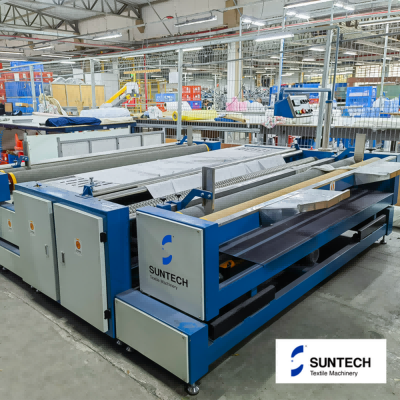With the rise of the fashion industry and the diversification of people's aesthetics, competition among garment factories has become increasingly fierce. When it comes to maintaining competitiveness, garment quality, and production efficiency are decisive factors.
Fabric relaxing technology, as a new type of fabric treatment process, has received increasing attention in recent years. This article will explore in depth the application of fabric relaxation technology in garment production, and analyze the advantages it brings.
Fabric Relaxing Technology Introduce
Fabric Relaxing Technology refers to the processes and machinery used to release the tension or stress that fabric accumulates during production, such as weaving, knitting, or the winding process. The goal of fabric relaxing is to return the fabric to its natural, relaxed state before it undergoes further treatments like dyeing, printing, or finishing.
Fabric Relaxing Technology Categories
1. Relaxing Machines: These machines unwind the fabric, applying controlled heat and/or moisture, and sometimes mechanical tension release, to help the fabric return to a relaxed, smooth condition. The fabric is typically passed through a series of rollers or tension zones, and steam or hot air may be used to soften it and eliminate any crimp or stretch.
2. Thermal Relaxing: Some fabric relaxing processes use heat to relax the fibers. This can be done by passing the fabric through hot-air chambers or using steam to relax the yarns, which helps reduce shrinkage and improves the fabric’s stability.
3. Moisture Relaxing: Adding moisture or steam to fabric helps fibers relax, especially in woven fabrics. This is often combined with heat to help the fibers regain their original dimensions and remove any tension created during the weaving process.
4. Mechanical Relaxing: Mechanical devices like tension rollers, stretching frames, or rollers in a fabric relaxing machine can help further smooth the fabric by removing creases and wrinkles, giving the fabric a more uniform appearance.
Impact of Fabric Relaxing Technology on Garment Factories
1. Improved Fabric Quality: By releasing tension, wrinkles, and creases from fabric, relaxing technology ensures that the fabric maintains a uniform and smooth texture. This results in better quality fabric that is more suitable for further processes like dyeing, printing, or finishing. For garment factories, this means fewer defects in the final product and a reduction in quality control issues.
2. Reduced Shrinkage: Relaxing the fabric helps minimize shrinkage during later stages, ensuring garments maintain their intended size and fit. This reduces the risk of customer complaints and returns due to size discrepancies.
3. Increased Efficiency in Production: Relaxing technology helps streamline the production process by making fabric easier to handle and work with. Fabrics that are tension-free and smooth are less likely to cause problems during cutting, sewing, or finishing. As a result, garment factories experience fewer machine stoppages, reduced downtime, and enhanced production speed, which can lead to higher throughput and profitability.
4. Improved Dyeing and Printing Results: Fabric relaxing technology ensures that the fabric is in its optimal state before undergoing dyeing or printing. This results in more consistent and uniform color application, preventing uneven dyeing or distortion in the fabric pattern. For garment factories, this means fewer reworks and better overall product quality.
5. Cost Efficiency: Though fabric relaxing machines require an initial investment, they can significantly reduce material waste, reprocessing costs, and the need for additional quality control measures. By ensuring the fabric is in the best possible state before further processing, the technology helps avoid costly mistakes and rework. This ultimately contributes to cost savings for garment manufacturers.
6. Better Fabric Handling: Relaxed fabric is easier to transport and store because it’s less likely to wrinkle, crease, or get damaged. Garment factories can avoid issues related to fabric handling, storage, and movement, leading to less damage and waste during inventory management.
7. Increased Flexibility: Fabric relaxing technology can handle a wide variety of fabrics, including delicate, stretchy, and synthetic materials. This allows garment factories to work with a broader range of fabrics, giving them more flexibility in their designs and products.
8. Sustainability: Relaxing technology can contribute to sustainability by reducing the amount of fabric wasted due to shrinkage or defects. Moreover, by ensuring the fabric is more stable before it undergoes dyeing or printing, the technology helps reduce the amount of water and chemicals used in these processes, contributing to more eco-friendly practices in garment production.

Automated Fabric Relaxing Machine
SUNTECH's new fabric relaxing machine is very suitable for high-elastic or Lycra fabrics. It combines 3 processes. The vibrating conveyor design releases tension through vibration, and the air flotation table blows air naturally without shrinking. Roll to roll, active unwinding, less tension feeding & rewinding.
Compared with traditional fabric relaxing methods, it saves more than 24 hours. Panel control, simple operation, it is a good choice if you want to upgrade your equipment.
Conclusion
Fabric relaxing technology positively impacts garment factories by improving fabric quality, reducing defects, enhancing production efficiency, and ultimately supporting cost-effective, sustainable, and high-quality garment manufacturing.




